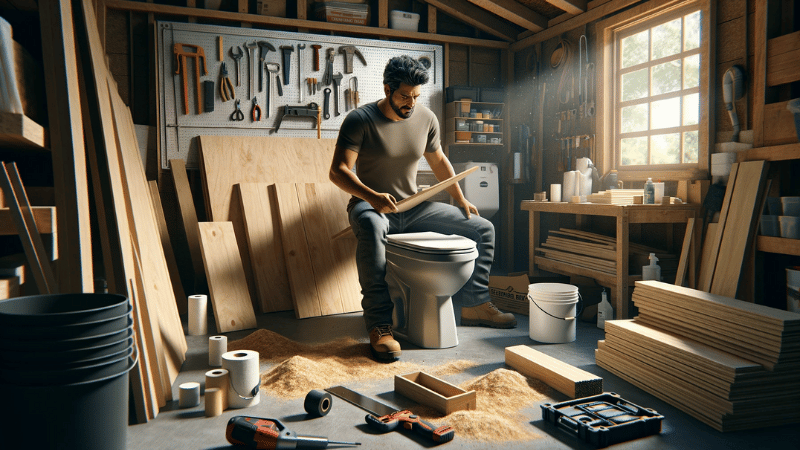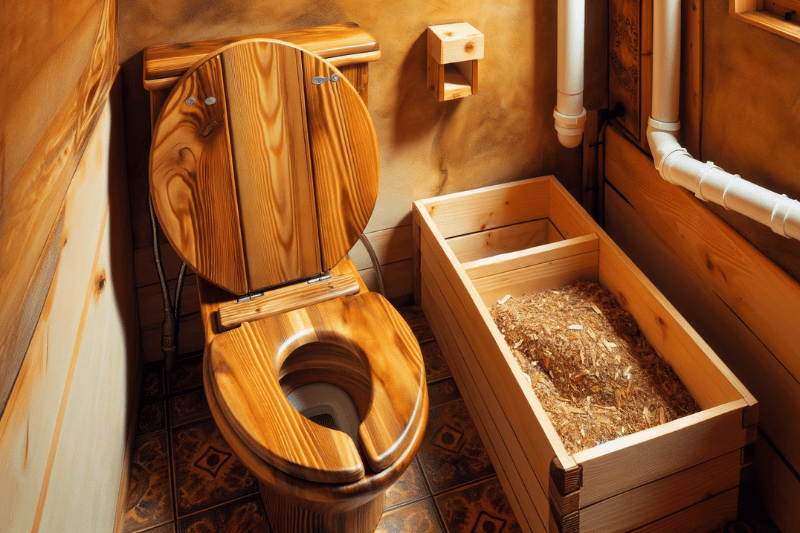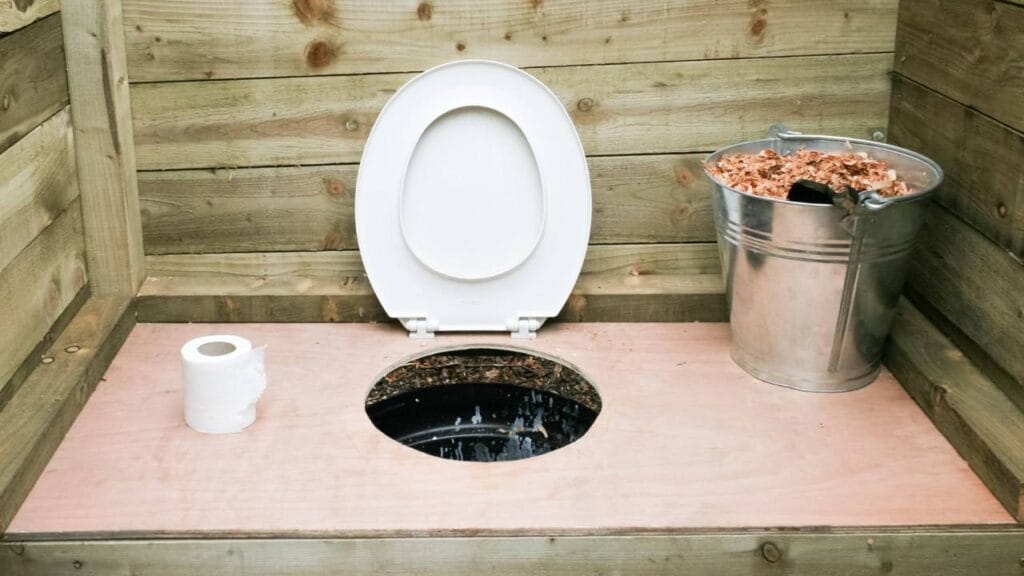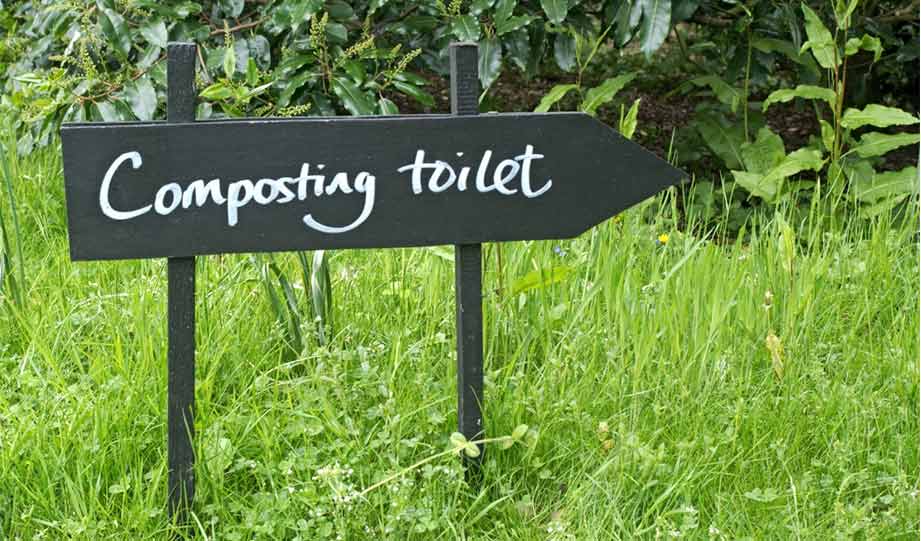Did you know that each of us, on average, poop about two times our body weight every year? That’s quite a pile! Now, here’s a shocker: almost a third of this waste is just food scraps and garden clippings. Imagine if we could turn this ‘waste’ into something wonderful.
Enter the world of composting – a simple yet magical process. Compost is this rich, organic material that gives a turbo-boost to your garden soil. Not only does it pump vital nutrients into the earth, but it’s also a hero in drought-stricken areas, helping the soil hold onto precious moisture.
But here’s the really cool part: what if I told you that you could also compost human waste? Yes, you heard that right! With a homemade composting toilet, you can be a part of this eco-friendly cycle. It’s surprisingly simple to build and a giant leap towards living more sustainably.
So, how about we dive into making your own DIY composting toilet? It’s easier than you think, and I’ll guide you through each step. After all, I’ve tried these methods myself, and the results?
Absolutely rewarding!
While we’re at it, let’s talk numbers for a second. Traditional toilets are huge water wasters, flushing away about 8,559 gallons per family each year. Switching to a composting toilet can save all that water, making a big splash in reducing your environmental footprint.
Ready to join the green revolution? Let’s start building that DIY composting toilet and transform the way we think about waste!
How To Build A DIY Composting Toilet

Ever wondered how to make a composting toilet yourself?
It’s easier than you think!
I’ve been down this road, and I’ll share some handy tips to make your DIY composting toilet project a breeze.
Materials You’ll Need
- Plywood: For crafting the top, bottom, and sides of the toilet box.
- Toilet Seat: Choose one that's sturdy and comfortable.
- Urine Separator: A device for separating liquid and solid waste.
- 2x4 Planks: For creating legs for the toilet box.
- Two Types of Buckets: (1) For liquids: A long, narrow container (like a 3.5-liter pot), (2) For solids: Standard 5-gallon buckets (keep at least three in rotation).
- Absorbent Material: Such as dried leaves, wood ash, or hardwood sawdust for the solid waste bucket.
- Paint or Stain: For finishing and protecting the wood.
- Screws: For assembling and attaching various parts.
Tools You’ll Need
- Saw: For cutting plywood.
- Pocket Hole Jig: To assemble the box with strong joints and hidden screws.
- Drill with Drill Bits: For drilling pilot holes and fitting screws.
- Jigsaw: To cut the hole in the plywood for the toilet seat.
- File and Sandpaper: To smooth out the edges of the cut hole.
- Screwdriver: For installing the urine separator and toilet seat.
- Pencil: For marking cut lines and screw holes.
- Measuring Tape: To measure and mark the plywood for cutting.
Let's Get to Building Your DIY Composting Toilet!
Step 1. Build The Box
Let’s kick off our DIY composting toilet project by building the box. Trust me, comfort is key here since you’ll be using it every day. I learned a couple of things about toilet comfort that might surprise you:
Finding the Right Height
Ever thought about the height of your toilet? It’s more important than you’d think. Taller toilets make sitting down and standing up a breeze. But, here’s a fun fact: doctors say squatting more can actually help with… well, you know. To find that sweet spot, I tried sitting on various objects around the house to measure the best height. Give it a go!
Choosing the Toilet Seat
This part is all about personal preference. Just make sure it’s sturdy and comfy. I mean, you’re going to spend a fair amount of time here, right?
Now, let’s get down to business. Think about the space you have and decide on the size of your toilet. Don’t forget to factor in the size of the toilet seat.
Grab your plywood and cut out six pieces for the top, bottom, and sides. Here’s a tip: use a pocket hole jig to put it all together. It makes the box super strong and hides those pesky screws.
Step 2: Making the Hole
Remember, the top of your plywood box should be easy to open. Why? Because you’ll need to get to that bucket underneath.
Grab your toilet seat and place it right on top of the plywood. Open it up, and with a pencil in hand, trace around the inside edge. This trick makes sure your hole is just the right size.
Here’s a tip from my own experience: cut the circle a tad bigger for some extra space. Start by drilling a pilot hole on your drawn line, then pop in your jigsaw blade and follow the outline. Don’t worry if it’s not perfect – I’ve been there, and a bit of imperfection adds character!
If your circle’s a bit rough around the edges, grab a file and some sandpaper to smooth it out. Trust me, a little elbow grease here makes all the difference.
Once your box is all set, why not give it a bit of flair? Staining or painting it not only protects the wood but also lets you add a bit of your own style to the toilet.
Step 3: Installing the Urine Separator
Next up in our DIY composting toilet project is adding the urine separator. This nifty device keeps things neat by directing urine into a separate container. It’s a game-changer for reducing odors and keeping the compost dry.
Just screw it onto the underside of the lid at the front. I found this step to be crucial for a fresher, more efficient toilet.
Step 4: Setting Up the Toilet Seat
Now, let’s get that toilet seat in place. Position it over the hole you’ve cut out and mark where the screws will go. A sturdy screwdriver and a bit of muscle are all you need to create snug holes for the toilet seat fittings.
This makes sure everything stays tight and secure, which is really important for a homemade setup.
Step 5: Adding Legs to Your Toilet
While your toilet box could sit directly on the floor, I recommend giving it legs. Why? Because bathroom floors get wet, and we don’t want our nice work getting soggy! Attach a 2×4 plank at each corner for stability.
When you put it on the floor, give it a little wiggle to make sure everything’s steady. If there’s any wobble, tighten those screws!
Step 6: Choosing the Right Buckets
Almost there!
Now, for your DIY composting toilet to work, you need two buckets: one for liquid and one for solids. For liquids, a long, narrow container works best. I used a 3.5-liter pot, and it was perfect.
For solids, a standard 5-gallon bucket does the trick. Keep at least three in rotation, so you’re never caught off guard.
Step 7: Adding Absorbents
Lastly, let’s talk about keeping things odor-free. Add a few inches of absorbent material, like dried leaves, wood ash, or sawdust, into the solid waste bucket.
I found hardwood sawdust to be the best at soaking up moisture and neutralizing any unpleasant smells.
What Is A Composting Toilet?

A composting toilet is an eco-friendly waste management system that decomposes human excreta into compost using dry materials like sawdust, leaves, or wood ash. Unlike conventional toilets, it doesn’t flush waste with water but uses natural processes involving aerobic bacteria to convert waste into useful compost.
This innovative toilet is a game-changer, especially if you’re into recycling and sustainable living. Let me dive a bit deeper: Instead of sending waste down the drain, you mix it with organic materials. This mixture then goes into your compost heap, where it’s broken down into nutrient-rich compost with the help of straw and heat.
One of the coolest things about composting toilets is their water efficiency. They use minimal or no water at all, relying on natural bacteria to do the heavy lifting. And guess what? When built correctly, they don’t emit any unpleasant odors. Plus, they’re super versatile – you can install them virtually anywhere since they don’t require complex plumbing.
The beauty of composting toilets lies in their ability to conserve water and recycle waste into something beneficial for our environment. It’s a smart, sustainable solution that eases the burden on sewage systems and reduces water pollution.
For those of us who are environmentally conscious or living off-grid, a composting toilet is a smart, eco-friendly choice that supports a sustainable and self-sufficient way of life.
Different Types of Composting Toilets
When it comes to composting toilets, there’s more than one type to suit different needs and spaces.
Let’s dive into the two main types:
1. Self-Contained Composting Toilets
These are like all-in-one kits. Everything happens right there in the unit beneath the toilet bowl. I’ve seen these work wonders in smaller spaces like tiny homes, boats, and RVs. They’re also a hit in seasonal homes like cabins and cottages.
From my own experience, what’s great about these is their simplicity and ease of installation. You don’t need a lot of space, and if you’re into DIY, adding one to your regular home can be a fun weekend project!
2. Split or Central Composting Toilets
Now, if you’ve got a bigger house, you might want to look into split or central composting toilets. These systems are more complex – they separate the business end (the toilet bowl) from the composting action, which usually takes place in a central system located elsewhere, like your basement or outside.
What’s cool about these is that if you have a large system, it can connect to multiple toilets in your house. To the untrained eye, these central composting toilets look just like your average toilet, but they’re doing so much more for the environment.
How Does A Composting Toilet Work?

Ever wondered how a composting toilet turns what we leave behind into something good for the earth? Whether it’s a compact model for your RV or a split-system for your home, they all work on a neat principle.
Here’s a simple breakdown:
- Agitator bar
- Compost chamber
- Fan and vent hose
- Flush door
- Flush handle
- Liquid bottle with handle
- Liquid drain
- Mounting screw
- Spider handle
The Composting Process
First, these toilets separate liquid from solids. The solids mix with materials like sawdust, creating the perfect environment for composting. Think of it as a recipe – the right mix is crucial. I usually line the chamber with something like dried peat moss or coconut fiber. This helps the bacteria do their thing and maintain the right balance.
For a simpler setup, just tossing a scoop of sawdust each time you go works wonders. The liquid waste goes into its own container, easy to remove and empty. And if things get a bit messy, a spray of water and vinegar does the trick without harming the composting process.
Now, the fun part: mixing. With a turn of the spider handle (attached to the agitator bar), you blend the new waste with the compost. If you’re doing a DIY version with a bucket, just add more sawdust on top.
Emptying and Maintenance
When it’s time to empty the toilet, start with the urine container. Dispose of it safely, following local guidelines. For the compost, check with your state’s health department for the best disposal practices.
If you find leftovers sticking to the chamber, a quick rinse with a garden hose and high-pressure attachment should do the trick. Pour the rinse water onto your outdoor compost heap, then dry the chamber and give it a vinegar spray. Remember, no harsh chemicals – they can mess with the good bacteria working hard to break down the waste.
Who Should Consider Getting a Composting Toilet?
Are you wondering if a composting toilet is right for you? Let’s explore who can benefit most from this eco-friendly innovation:
Eco-Conscious Individuals
If you’re passionate about reducing your environmental footprint, a composting toilet is a no-brainer. It saves water and recycles waste, making it a perfect fit for those committed to sustainable living.
Off-Grid Living Enthusiasts
Living off the grid? Composting toilets are ideal as they don’t require water or sewer connections. They’re a self-sufficient solution for remote cabins, tiny homes, and off-grid homesteads.
Homeowners with Water Scarcity
In areas where water is a precious commodity, composting toilets offer a practical solution. They use little to no water, making them perfect for drought-prone regions.
RV, Boat, and Tiny Home Owners
Limited space? No problem. Composting toilets are compact and don’t need plumbing, making them great for RVs, boats, and tiny homes where space and resources are at a premium.
Gardeners and Farmers
If you love gardening, composting toilets provide a free source of nutrient-rich compost for your plants. This is an excellent way to recycle nutrients back into your garden.
DIY Enthusiasts
Love a good DIY project? Building your own composting toilet can be a rewarding and practical project that also benefits the planet.
Those Seeking to Reduce Water Bills
Want to cut down on utility costs? Composting toilets significantly reduce water usage, leading to lower water bills.
Sustainable Developers and Builders
If you’re building eco-friendly homes or developments, incorporating composting toilets can be a major selling point for environmentally conscious buyers.
Festival and Campsite Operators
For those managing festivals or campsites, composting toilets can be an efficient, low-impact alternative to traditional portable toilets.
Benefits of Building A Composting Toilet
Greener Alternative To Septic
Septic tanks are expensive, and in certain layout and land conditions, the use of a septic tank would not be possible at all. Not to mention environmental regulations that may prohibit the use of septic tanks where you live. A DIY composting toilet, on the other hand, lets you deal with your stuff on your property in the greenest possible way — by turning it into food for plants.
Conserves Water
Even in this time and age, there are regions that struggle with water scarcity, and not all of them are in developing countries. When compared to traditional toilets that waste up to 5 gallons of water on a single flush, for a DIY composting toilet described here, you need very little to no water.
Even when sewage makes it to the treatment plant, it takes a huge amount of money and energy to clean all that wastewater, and the process must be repeated over and over as the water is cycled back through people’s toilets. I think that you should really make people understand how stupid it is to poop into clean water.
— Cecilia Lalander, Environmental Engineering Researcher at the Swedish University of Agricultural Sciences in Uppsala
No Plumbing Required
If you’re looking into compost toilet DIY tutorials, chances are that you plan to use one where plumbing is not available, such as an outdoor cabin. A composting toilet is also a great option for an old building, where plumbing is either inefficient or non-existing. From an environmental point of view, having a composting unit makes much less impact than you having to tear out the old and running new pipes through the building.
Inexpensive
While you can go and buy a ready-made composting toilet, this is all about being self-sustainable and making do with materials you have at hand, with minimum waste. The 5-gallon bucket version with a plywood frame and urine separator will set you back about $10. You won’t be creating any waste and won’t have to pay for someone to install it.
Odorless Option
When compared to an outhouse, a DIY composting toilet has a significant advantage — you don’t have to deal with foul odors in your property. Helped with the carbon material, the whole composting process is carried out by bacteria under aerobic conditions. The final product is eco-friendly odorless compost which you can use in your garden.
Frequently Asked Questions (FAQ)
Yes, you can make your own composting toilet. A composting toilet is easy to build with a few basic hand and battery tools. All you need are a few sheets of thick plywood, a toilet seat assembly, screws, and a bucket with the absorbent material. You can even create a simpler unit by using a medical toilet seat.
Yes, you can pee in a composting toilet. In that case, you’ll have to use more absorbent material, like sawdust, to neutralize the odor, as urine and feces also smell much worse together. Sawdust is rich in carbon and you need more of it to balance the extra nitrogen content, so composting can take place.
No, composting toilets don’t smell bad. If you follow the instructions and make sure there is enough absorbent material in the bucket you won’t have to deal with bad smell. If you want to be extra sure, you can install a vent with a small 12V computer fan that activates every time you open the lid.
Yes, you can use human feces for compost. Keep in mind that it’s much easier to compost feces from a toilet with a urine separator. While some municipalities recommend using this type of compost only for flower beds, if you use a hot compost heap, you can use it on your vegetable patch safely as well.
You can get rid of composting toilet waste by emptying it onto your outdoor compost bin. If you used plenty of damp sawdust or peat moss, the bucket won’t smell bad, and you can rinse it with a garden hose, dry it, and spray it with vinegar. No chemical cleaners needed.
Yes, you normally use toilet paper with a composting toilet. Toilet paper won’t decompose as quickly as feces so it will be visible long after the matter has broken down. You can use any type of paper, but keep in mind that marine and RV paper will compost the quickest. You should never throw diapers, wipes, and tampons in a compost bin.
You can dump a composting toilet on your composting heap or apply it directly to your garden. Between November and April you shouldn’t apply compost to your plants, so dump the content of your bucket into a composting bin or heap. In warmer months, empty the toilet directly at the base of shrubs and flower beds.
No, you don’t need electricity for a composting toilet. The best thing about compost toilets is that they can be used off-grid, with zero power, emissions, and pollution. If you use one in your home and want to eliminate any chance of bad odor, you can use a small 12V computer fan for venting.
Yes, earthworms can eat human waste. They live off any organic matter that is composting. When given human excrement, they will digest it and convert the remaining material into their excrement, called worm castings. Worm castings are among the best balanced natural plant foods there is.
You can make a compost toilet not smell by making sure there’s always enough absorbent material in the bucket. For this, you can use hardwood sawdust, dried peat moss, dry leaves, or coconut coir. You can also install a small computer fan to vent any lingering odors outside.
In a composting toilet, you don’t actually use conventional dirt. Instead, you add a carbon-rich material, such as sawdust, coconut coir, peat moss, or wood shavings, to aid in the composting process and to reduce odors by balancing the carbon-to-nitrogen ratio.
Yes, a urine diverter is highly recommended for a composting toilet. It separates urine from solid waste, reducing moisture and odor, which facilitates the aerobic composting process and improves the efficiency and hygiene of the system.
For a composting toilet, you’ll need a container for waste, a urine diverter, a ventilation system, a cover material like sawdust or peat moss, and possibly a composting agent to accelerate decomposition. Tools for assembly and personal protective equipment for handling waste are also essential.
The frequency of emptying a composting toilet varies depending on usage and size, but typically, the solid waste compartment needs to be emptied every 1-4 weeks. Regular maintenance ensures optimal composting and prevents odors.
Yes, you can put coffee grounds in a composting toilet. They are a beneficial addition, providing nitrogen to the composting process. However, they should be used sparingly to maintain the right carbon-to-nitrogen balance and to avoid excess moisture.
Yes, you can use biodegradable kitty litter, such as those made from wood pellets or paper, in a composting toilet. They help absorb liquids and control odor. However, avoid clumping or clay-based litters, as they don’t break down well in the composting process.
Embark on Your Eco-Friendly Journey with a DIY Composting Toilet
As we reach the end of our exploration into the world of composting toilets, I hope you’re feeling inspired and ready to take the leap. Building a DIY composting toilet isn’t just a project; it’s a step towards a more sustainable and environmentally conscious lifestyle.
Imagine the satisfaction of creating something that not only saves water and reduces your ecological footprint but also provides rich compost for your garden. This isn’t just a toilet; it’s a statement of your commitment to the planet.
Whether you’re in a tiny home, a rural cabin, or just looking to make a positive impact in your urban residence, a DIY composting toilet is a practical, cost-effective solution. It’s about embracing a greener lifestyle, one flush at a time – well, without the actual flush!
I encourage you to take this information, channel your inner DIY spirit, and start building. Remember, every small step we take towards sustainability has a ripple effect on the health of our planet. Your decision to build a composting toilet is more than just a personal win; it’s a win for our environment.
So, gather your tools, rally your enthusiasm, and embark on this rewarding journey. You’re not just building a toilet; you’re building a better future.


